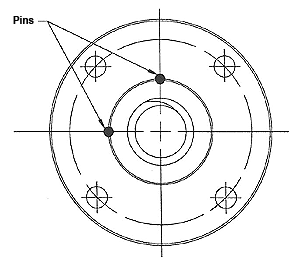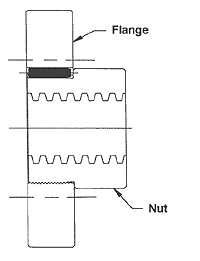Posted April 26, 2019 - Updated Dec 4, 2019
(Engineering Bulletin #/web964)
Key torque (the torque on a nut necessary to produce a linear motion) may be high enough to unscrew a nut from its mating flange. Smaller sizes may be secured with a thread locking compound or with a locking set screw which applies a radial locking force against the threads.
Securing Flanges to Acme Nuts
A more secure method recommended for all larger sizes and especially for highly loaded assemblies makes use of a longitudinal pin arrangement sometimes called a “Dutchman pin”. To utilize this method, follow the steps below:
- Remove all lubricants, oils or grease from the flange and nut. Assemble the nut and flange until the shoulder on the nut is snug against the face of the flange.
- Carefully drill two holes at 90 degrees in the center (approximately at the Vee thread pitch diameter) of the attachment threads as shown in the illustration.
- Press two locking pins into each hole approx. 1/16 below flush. A solid, unhardened grooved pin works best. Solid, hardened dowel pins can be used but are difficult to remove by drilling out.
- After assembly of the pins, stake the edges of the holes to prevent the pins from disengaging. Staking is recommended for all installations, but, may not be necessary if the flange’s mating surface traps the pins in place.
- Check to make sure the stake marks do not protrude beyond the face of the flange. If so, they must be dressed flush with a file or stone.
- The nut and flange are now secured. Carefully clean all surfaces to remove all metal chips before assembling mating screw and placing parts in service. Be certain that no metal chips remain in the Acme threads of the nut.

